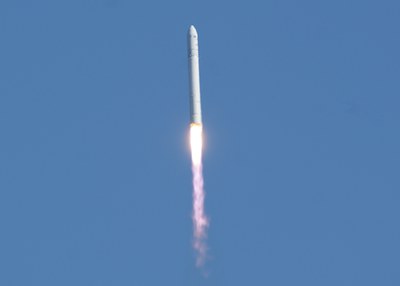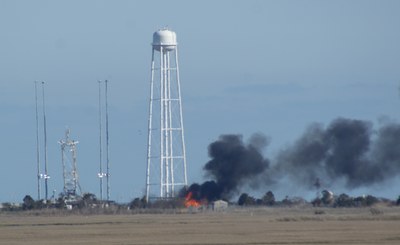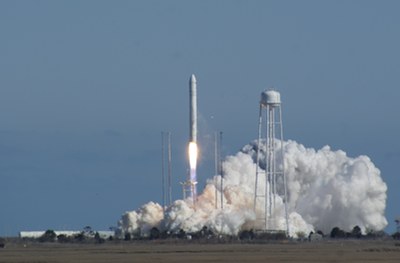Antares risingby Jeff Foust
|
| When an umbilical disconnected from the rocket’s second stage 12 minutes before launch Wednesday, controllers had no choice but to pull the plug, so to speak, on the launch. |
Those concerns had to be on the minds of those intensely watching, in person or via the web, the first launch of Orbital Sciences Corporation’s Antares rocket last week. The mission, designed A-ONE by Orbital, was clearly described by Orbital and NASA alike as a test flight, to see how the vehicle performed before Orbital flew the first of its Cygnus cargo spacecraft to the International Space Station on it. Nonetheless, a lot was riding on the launch for the company and the space agency.
First, though, the rocket had to get off the ground. On Wednesday, the first launch attempt from the Mid-Atlantic Regional Spaceport (MARS) on Wallops Island, Virginia, all was looking good: the countdown was proceeding normally and the weather was cooperating. Then, with about 12 minutes left until the scheduled 5 pm EDT (2100 GMT) launch, one of those unforeseen and perhaps untestable issues cropped up on the pad: an umbilical between the rocket’s second stage and the Transporter Erector Launcher (TEL) that acts as the rocket’s gantry disconnected, severing a data link. Launch controllers had no choice but to pull the plug, so to speak, on the launch.
Orbital explained after the scrub the problem was a combination of two factors: limited slack in the umbilical and a “slight hydraulic movement” in the TEL, the combination of which caused the cable to disconnect. The company said it would make slight adjustments to both the umbilical and TEL to prevent the problem from happening again.
Orbital officials emphasized that, other than this glitch, the countdown was proceeding well, particularly for a first launch. “Given that this is a first run for the rocket and the first time use of a new launch facility, the fact that all systems were performing as planned while the team proceeded through the pre-launch checklists is very encouraging. It speaks volumes about the quality of the work done by this team and our partners,” said Frank Culbertson, executive vice president of Orbital and mission director for the launch, in a statement after the scrub.
 Orbital’s Antares rocket ascends towards orbit during its launch on April 21. (credit: J. Foust) |
Orbital rescheduled the launch first for Friday, but then shifted it to Saturday because of poor weather forecast as a cold front passed through the region late Friday. Saturday dawned with high clouds that were gradually clearing and prospects of good weather: a 90-percent chance of acceptable weather at launch time, according to initial forecasts. Yet it was weather that posed the next obstacle to the launch.
The problem was not with the clouds or with ground conditions, where winds were light, but with much stronger winds at higher altitudes. The passage of the front brought with it high winds at higher altitudes, and models showed that if there was a launch failure, debris could be blown beyond established limits. Under those conditions, the launch could not take place.
Orbital delayed fueling of the rocket by over an hour, hoping that updated wind data from weather balloons would show improving conditions, but by 4:30 pm EDT Saturday it was clear the winds wouldn’t improve in time before the launch window closed at 7 pm. “It was still red, and the trend towards green was not nearly strong enough, so we made the decision to go and scrub at this point,” Culbertson told reporters late Saturday afternoon. Making the decision to postpone the launch before fueling the vehicle preserved the opportunity for another launch attempt on Sunday. And, as many pointed out, the third time’s the charm, right?
On Sunday, the upper-level winds had subsided, and conditions on the ground, while a bit breezy, were still within acceptable limits. The weather was now cooperating, and so was the range (although one boat had to be “chased out,” in the words of launch controllers, by the Coast Guard when it strayed into the restricted zone within an hour of launch.) Success was in the hands of a promising, but still untried, rocket.
Prior to the launch, Orbital warned that unlike the company’s smaller, solid-fueled rockets, Antares would take off more slowly. Two seconds after the first stage’s twin AJ26 engines ignited, the rocket would lift off the pad. Eight seconds later, the rocket would still be traveling at 65 km/h and be just 70 meters of the pad; it would take over a minute after that for the rocket to exceed Mach 1.
| “If you watched our progress over the last few years, you know that this is not easy. Making it look easy takes a lot of hard work,” said Culbertson. |
That ponderous flight, not uncommon for larger liquid-fueled rockets, added another dimension to the drama. But as the countdown reached zero, the engines ignited on cue, and two seconds later the rocket began its slow but certain ascent. The glitches in the earlier launch attempts were forgotten as controllers repeatedly noted conditions were nominal as the rocket soared into the late afternoon sky. The first stage worked as planned and then jettisoned; after a brief coast period the rocket’s payload fairing and interstage adaptor also were released and the Antares second stage, a Castor 30 solid motor from ATK, ignited. Ten minutes after that slow-motion liftoff, the rocket released its payload, a simulated Cygnus spacecraft and several smallsats, into low Earth orbit, ending a successful mission.
“Today did go extremely smoothly, and it’s a real testament to the team that it did,” Culbertson said in a post-launch press conference Sunday. “But if you watched our progress over the last few years, you know that this is not easy. Making it look easy takes a lot of hard work.”
Culbertson said that all initial indications were that Antares performed just as planned, with every mission milestone taking place within a second of the plan. He said engineers would spend several days performing a preliminary analysis of the data collected during the launch, but would continue to analyze it in greater detail as the company prepares for the next Antares launch in the summer.
Alan Lindenmoyer, manager of NASA’s Commercial Crew and Cargo Program, indicated he was ready to declare the launch a success even before that preliminary analysis of data was complete. “As soon as we saw separation of the payload, that was really the end of the primary mission objectives we established,” he said, referring to NASA’s Space Act Agreement with Orbital, part of the Commercial Orbital Transportation Services (COTS) program, that is supporting development of Antares and Cygnus. “It’s certainly not going to take days for us to conclude that the primary objectives were met.”
 A brush fire burns near the launch pad after liftoff. (credit: J. Foust) |
One minor issue with the launch was not with the rocket itself but the launch site. As the rocket disappeared from view, those at the launch turned back to the launch pad at MARS and saw clouds of black smoke billowing from the vicinity. The launch apparently set of some brush fires nearby, but nothing that damaged the launch pad. “It doesn’t appear that anything around the pad was burning,” Culbertson said.
The launch was a major success for both Orbital and NASA. For Orbital, Antares represented not only the largest rocket the company had ever built, but also a major bet on the company’s future. Orbital hopes Antares can launch not just Cygnus cargo missions, but other satellites, for the US government in particular, that previously flew on the Delta II, a medium-class rocket that will be retired in the next few years. Antares will provide “right-size and right-price” launch services, as the company terms it, for such payloads, a subtle reference to the fact that such satellites now have to use the larger, and more expensive, EELV-class Atlas V and Delta IV.
For NASA, the launch was another vindication of its approach to turn to the commercial sector to launch cargo and, eventually, crews to the ISS. “It was a great day for NASA, and another historic day for commercial spaceflight in America,” said Lindenmoyer. Assuming Orbital can also successfully demonstrate its Cygnus spacecraft later this year, NASA notes that this provides true competition for ISS cargo services going forward (although unlike SpaceX’s Dragon spacecraft, Cygnus will not be able to return cargo to Earth.)
| “Rockets are hard. Spaceflight is difficult. And getting off the ground is a real challenge.” |
“Today’s successful test flight of Orbital Sciences’ Antares rocket from the spaceport at Wallops Island, Virginia, demonstrates an additional private space launch capability for the United States and lays the groundwork for the first Antares cargo mission to the International Space Station later this year,” John Holdren, director of the Office of Science and Technology Policy, said in a statement issued immediately after the launch. “The growing potential of America’s commercial space industry and NASA’s use of public-private partnerships are central to President Obama's strategy to ensure US leadership in space exploration while pushing the bounds of scientific discovery and innovation in the 21st century.”
A third, and often overlooked, winner in the successful Antares launch is the local community. The state of Virginia and other government agencies, along with Orbital, invested about $140 million to develop the Antares launch site at MARS, hoping to attract high-tech economic development to a largely agricultural region. “That’s a pretty good investment in the Eastern Shore, and I think it’s paid off,” Culbertson said. Orbital people have moved to the region to work on Antares, he said. Local officials, he added, “seem really happy that we’re here and that we’re bringing more business to the Eastern Shore.”
Now attention turns to the next Antares launch this summer to fly the first Cygnus spacecraft. “I’m not going to hold my breath any less on the next one than I did on this one. Every launch is a challenge,” Culbertson said. “Rockets are hard. Spaceflight is difficult. And getting off the ground is a real challenge.” It is, though, as Orbital demonstrated Sunday and others have in the past, an achievable challenge.
